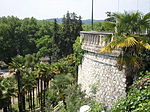Pau, Pyrénées-Atlantiques

Pau (French pronunciation: [po], Occitan pronunciation: [paw]) is a commune overlooking the Pyrenees, and prefecture of the department of Pyrénées-Atlantiques, region of Nouvelle-Aquitaine, France.The city is located in the heart of the former sovereign principality of Béarn, of which it was the capital from 1464. Pau lies on the Gave de Pau, and is located 100 kilometres (62 mi) from the Atlantic Ocean and 50 kilometres (31 mi) from Spain. This position gives it a striking panorama across the mountain range of the Pyrenees, especially from its landmark "Boulevard des Pyrénées", as well as the hillsides of Jurançon. According to Alphonse de Lamartine, "Pau has the world's most beautiful view of the earth just as Naples has the most beautiful view of the sea." The site has been occupied since at least the Gallo-Roman era. However the first references to Pau as a settlement only occur in the first half of the 12th century. The town developed from the construction of its castle, likely from the 11th century by the Viscounts of Béarn, to protect the ford which was a strategic point providing access to the Bearn valleys and to Spain. The city takes its name from the stockade (pau in Béarnese) which surrounded the original castle. Pau became the capital of Béarn in 1464 and the seat of the Kings of Navarre in 1512 after the capture of Pamplona by the Kingdom of Castile. Pau became a leading political and intellectual centre under the reign of Henry d'Albret. With the end of Béarnaise independence in 1620, Pau lost its influence but remained at the head of a largely autonomous province. It was home to the Parliament of Navarre and Béarn during the Revolution, when it was dismantled to create the Department of Basses-Pyrénées. The Belle Époque marked a resurgence for the Béarnaise capital with a massive influx of wealthy foreign tourists, who came to spend the winter to take advantage of the benefits of Pau's climate. It was at this time that Pau became one of the world capitals of the nascent aerospace industry under the influence of the Wright brothers.With the decline of tourism during the 20th century, Pau's economy gradually shifted towards the aviation industry and then to petrochemicals with the discovery of the Lacq gas field in 1951. The Université de Pau et des Pays de l'Adour, founded in 1972, accounts for a large student population. The city plays a leading role for Béarn but also for a wide segment of the Adour area. Pau's heritage extends over several centuries, its diversity and its quality allowed it to obtain the label of City of Art and History in 2011. The name of its people is Palois in French, and paulin in Occitan. The motto of Pau is in Latin: Urbis palladium et gentis ("protective of the city and its people").
Excerpt from the Wikipedia article Pau, Pyrénées-Atlantiques (License: CC BY-SA 3.0, Authors, Images).Pau, Pyrénées-Atlantiques
Rue Nogué, Pau
Geographical coordinates (GPS) Address Nearby Places Show on map
Geographical coordinates (GPS)
| Latitude | Longitude |
|---|---|
| N 43.3 ° | E -0.37 ° |
Address
Rue Nogué
64000 Pau, Centre Ville
Nouvelle-Aquitaine, France
Open on Google Maps








